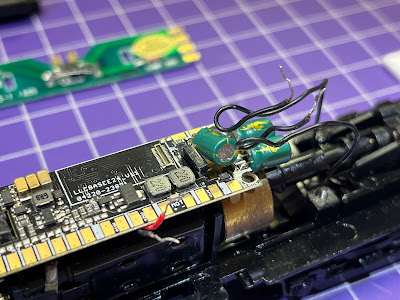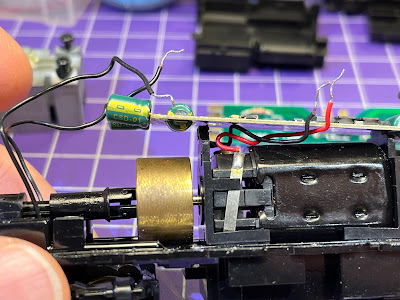I was excited to finally get started on my New Haven DERS-2c #529 project - click here for why and what all I got in preparation.
Unfortunately, I've run into a major roadblock: The ESU "Drop In" decoder, with integrated Power Packs (#58921) does not actually "drop in" to the Atlas Classic RS-3 model I wanted to convert. In fact, it doesn't fit at all as designed.
Read on to see why - and hopefully to avoid the same (major) mistake I made . . .
 |
| ESU photo |
ESU's Loksound 5 DCC Direct with Integrated Power Pack decoder (#58921) promises a relatively easy DCC conversion, with the bonus of having "keep alive" capacitors already installed on the motherboard. While not a true "drop in" that doesn't require soldering (like the version without the capacitors (#58821)), both decoders are touted as an "easy" board replacement. I can't speak to the 58821, but I know that's not the case with the 58921 - at least not in an Atlas Classic RS-3.
 |
| When you try to attach the board to the loco as indicated, you discover that the slots are a little too close together to allow an easy install. Note the slot on the left. . . |
 |
| The spacing between the slots is a good 16th to 3/32" too short. |
But the board is supposed to fit, right? Maybe I'm being too picky?
Thinking so, I decided to press a little harder . . .
 |
| That was a mistake . . . |
 |
| A BIG mistake! |
Note that the leg of the capacitor didn't break at the solder joint - it actually pulled the solder pad up with it(!!)
So the conversion of this Atlas model into NHRR DERS-2c #529 is sidelined for the time being. But hopefully, it'll only be a temporary setback and I'll be able to continue the install soon. Fingers crossed!
PS: If any of you reading this have actually installed the 58921, please let me know. I'd really be interested in learning how you did it.


A real "ooohh, fuuuuuuddggge" moment. I picked up an Atlas Classic RS1 a while back and went down the rabbit hole trying to outfit, and landed on the build that ScaleSoundSystems did (https://www.scalesoundsystems.com/product-page/atlas-classic-kato-rs1 - dual speakers? Heck yes!). In doing the research, I got the feeling that there were multiple variations of the Classic RS1. I'm not going to try to recount them, but as I compared what I bought to images I found online, I saw a few variations. And I do know there is a Classic and a Master. I wanted the same stay-alive configuration as you so I'm interested to see how this goes.
ReplyDeleteThanks for stopping by Ben! I just got the replacement board in the mail from ESU - brand new board, no questions asked. Looking forward to installing it, but now likely won't get to it until after New Years. Happy Holidays and stay tuned!
ReplyDelete